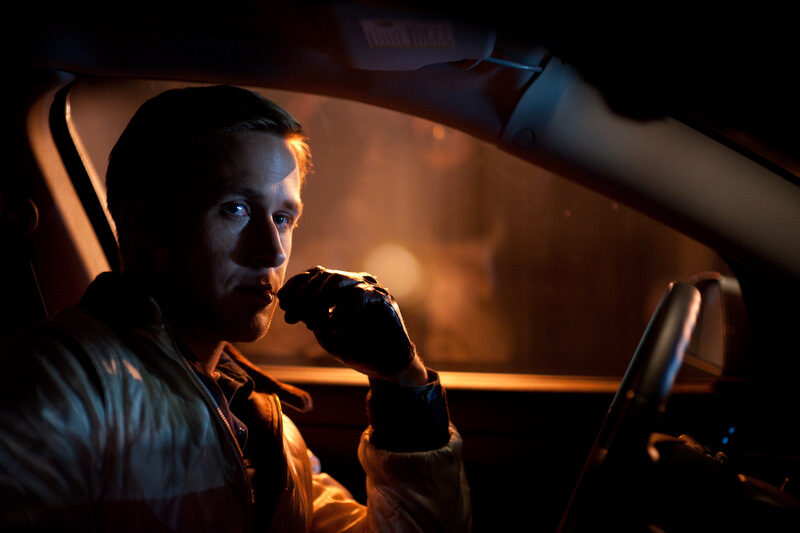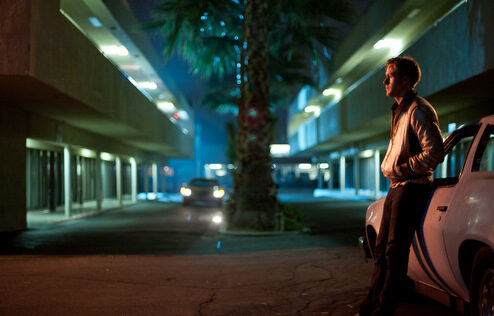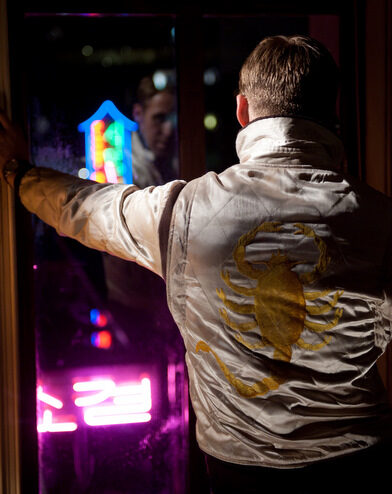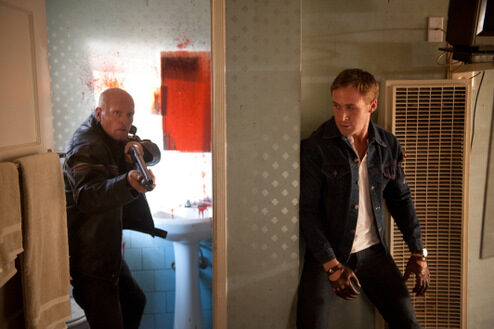Review: Drive | Clothes on Film
© 2011, FilmDistrict 
13 Sep ’11 Filed under Clothes from now, Film Reviews, Guys in Films. Tagged American Gigolo, Bryan Cranston, Carey Mulligan, Drive, Driver, driving gloves, Erin Benach, gloves, jacket, Jean-Pierre Melville, Jeans, Kinnemaniac, Le Samourai, leather, Nicolas Winding Refn, Richard Gere, Ryan Gosling, satin, scorpion jacket, Simon Kinnear, Steve McQueen, synthetic. Bookmark the permalink. Post a comment. Leave a Trackback (URL).
Starring: Ryan Gosling, Carey Mulligan, Bryan Cranston
Directed By: Nicolas Winding Refn
On the surface, Drive is effortlessly stylish, old-school filmmaking that luxuriates in its retro fashion. Yet, as Simon Kinnear reveals, underneath the hood, lurks a troubling character study.
It has become something of a cliché to acknowledge the debt owed by the Movie Brats of the 1970s to the European auteurs of the 1950s and 1960s. Woody Allen idolised Ingmar Bergman, Paul Schrader wrote a book about Bresson and Dreyer, both Brian De Palma and Francis Ford Coppola ripped-off Antonioni’s Blow-Up, and Scorsese littered his films with allusions to Godard and Visconti.
Yet arguably the most blatant steal came from a gaggle of genre filmmakers – Walter Hill, Michael Mann and William Friedkin – who took one look at the existential thrillers of Jean-Pierre Melville, notably hitman movie Le Samourai, and said, “That’s great, but clearly what it needs is a good car chase”. Hill’s The Driver, Friedkin’s To Live And Die In L.A. and Mann’s Thief relocated Melville’s archetypal lone-wolf, a professional forced to fight for control by the messiness of life, to America’s urban jungle and provided Hollywood with a new template for its thrillers.

The style of Drive, its look, sound, clothing, is rooted in the 1980s. Erin Benach’s costume design puts Ryan Gosling in a white satin bomber jacket (tailored by Richard Lim in LA) and tight indigo jeans by Acne.
These films share a world of sleek surfaces and ostentatious style, fuelled as much by modish electronica and gauche fashion as their narratives’ sine wave ripples between glacial inactivity and hard-hitting action. So seductive was this pop-art approach that it bled into other genres, from the gangster (De Palma’s Scarface) to character drama (Schrader’s American Gigolo).
It is fair to say that Nicolas Winding Refn has seen most, if not all, of these films. It is also quite probable that the Danish director realises that his second American movie belatedly reclaims the existential thriller for its European pioneers. Refn gleefully restages that familiar late-70s/early-80s style with studied retro elegance, from the pink scrawl of the graphics to the pulsating synths of Cliff Martinez’s score. As the film’s anti-hero, Ryan Gosling channels the ambiguous, amoral pretty-boy blankness of Ryan O’Neal in The Driver and Richard Gere in American Gigolo – in many ways, Gosling’s character is himself a gigolo, but one who seduces cars rather than women.
There is more to Drive than the postmodern appropriation of old-school filmmaking. Refn and Gosling are astute enough to recognise that this small band of movies effectively comprises a subgenre, with codes and symbols to be deconstructed and reinvented. There is something sociopathic about the obsessed/repressed heroes of Drive’s influences, so Refn turns his film into a satirical study of a guy who foregoes human society for the anonymous thrill of getting behind the wheel.

If Gosling’s unnamed driver is a superhero, the Scorpion logo is his ‘Bat symbol’. It was inspired from Nicolas Winding Refn’s love for experimental short film Scorpio Rising (1964).
What does Gosling do? “I drive” – in fact, the character is never named, and the credits refer to him only as “Driver.” In Los Angeles, city of cars, a guy can make a living hopping between gigs as a Hollywood stuntman, a mechanic, a sports racer and a getaway driver for bank robbers. In true Heat style, he gives criminals five minutes and no more. But for all Driver’s implacable, unflappable charisma, there is a rage and impatience here: petrolheads do not like to be held up. A man of few words, Gosling speaks through movement: his walk is gliding, his profile aquiline, and his dress sense is pimped up. In short, he pretty much is a car.
Both Refn and Gosling have stated in interviews that Drive is a superhero movie. “All the good ones were taken, so I made up my own,” quipped Gosling to Total Film. But, actually, they have a point. Several recent superhero films, notably Kick-Ass and Super, have centred on the transgressive liberation that comes from wearing a mask. Refn and Gosling take this to a logical conclusion: if the clothes fit, the mask becomes a grotesque afterthought.
Gosling defines himself by his anonymity, his shell-like identity as a driver, and so he wears his clothes like a costume – apt, really, given that he is employed by Hollywood. His white satin jacket is a beacon of flashiness, its scorpion-motif as distinctive as the spiders and bats that adorn certain other superheroes’ uniforms, but it’s also such a snug fit that it resembles a cocoon around Gosling’s slim frame that distances him from his peers. That isolation is enhanced by the jacket’s accessories: a toothpick (a cool Steve McQueen-esque gimmick that also acts as a deterrent to communication) and a pair of leather driving gloves; practical at work, sure, but also symbolic of a man who does not want to get his hands dirty. Usually, people talk about the gloves coming off when there is violence to mete out; Gosling’s Driver is at his most chilling after he’s put them on.

The gloves stay on: symbolic of a man who does not want to get his hands dirty. Gosling’s dark brown leather driving gloves were also specially made in LA.
The irony is that Driver’s costume is not complete with its most essential accessory: a car. Without his shield, this superhero is off-guard, which is why things start to go wrong when he picks up a passenger for longer than the five minutes he usually allots them. The plot centres on Driver’s tentative, charming relationship with Carey Mulligan’s neighbour Irene, but her complex home life soon sees Driver taking risks he would never consider behind the wheel.
In the film’s most astonishing scene, Driver ditches the toothpick for a long, lingering kiss with Irene, only for the romantic spark to ignite a sudden eruption of brutality. For a guy who prefers the synthetic appeal of satin and alloy, any kind of physical contact is a violent business. And where the car chases are graceful, even serene, the violence gets more brutal and random as Gosling loses control. The urge to speed, that relentless forward momentum, never dies – but on foot it is much harder to look cool. By the end of the film, Gosling is still wearing that satin jacket but, like Bruce Willis’ vest in Die Hard, it can’t really be called white any more – much like Driver’s own reputation.
By Simon Kinnear. Read more of Simon’s work in Total Film and at his blog Kinnemaniac.
Drive is released in the UK on 23rd September.
© 2011 – 2012, Simon Kinnear.
Related Posts: